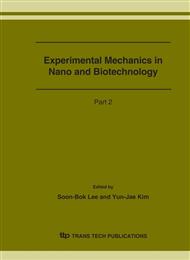p.187
p.191
p.195
p.199
p.203
p.207
p.211
p.215
p.219
Elastic and Plastic Mechanical Properties Determined by Nanoindentation and Numerical Simulation at Mesoscale
Abstract:
This work presents a comparison of numerical simulation and experiment of nanoindentation testing. A commercial finite element code ANSYS is adopted in the numerical simulation, in which elastic-plastic properties are considered. A PMMA specimen and a three side pyramidal Berkovich probe tip is used in the indentation tests. While the elastic-linear workhardening properties are adopted, the numerical results agree well with the experimental data for different indentation loads. It proves the numerical simulation can be used in the small scale analysis.
Info:
Periodical:
Pages:
203-206
Citation:
Online since:
December 2006
Authors:
Price:
Сopyright:
© 2006 Trans Tech Publications Ltd. All Rights Reserved
Share:
Citation:


